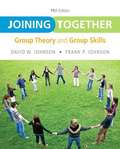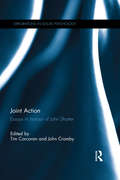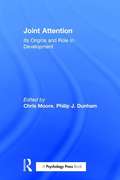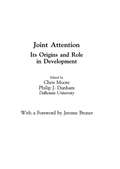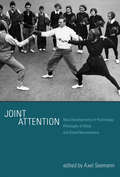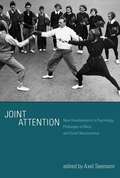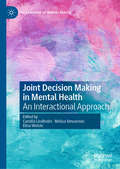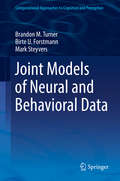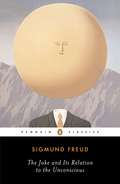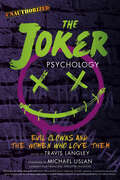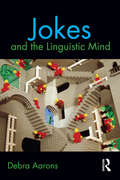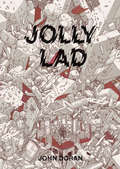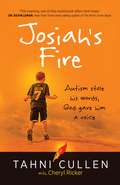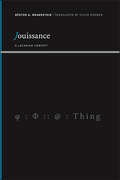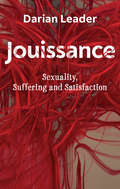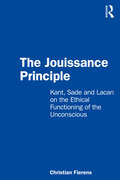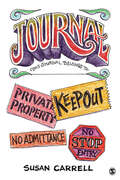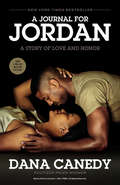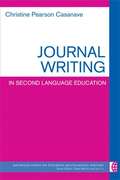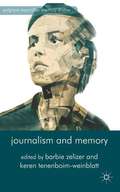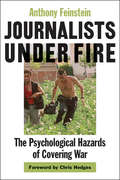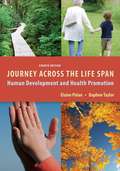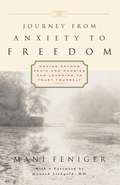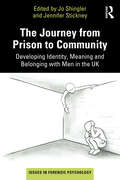- Table View
- List View
Joining Together: Group Theory and Group Skills
by David W. Johnson Frank P. JohnsonJoining Together introduces readers to the theory and research needed to understand how to make groups effective and, through exercises and thorough explanations, equips them with the skills required to apply that knowledge to practical situations. Chapters discuss the history of groups and group dynamics, the nature of experiential learning, group goals, communication within groups, leadership, power, decision making, controversy and creativity, and conflict management. More applied chapters focus on valuing diversity, cooperative learning, leading counseling groups, and team development and training.
Joint Action: Essays in honour of John Shotter (Explorations in Social Psychology)
by Tim Corcoran John CrombyJoint Action: Essays in honour of John Shotter brings together a cross-disciplinary group of fifteen respected international scholars to explain the relevance of John Shotter’s work to emerging concerns in twenty-first century social science. Shotter’s work extends over forty years and continues to challenge conventional scientific thinking across a range of topics. The disciplines and practices that Shotter’s work has informed are well established throughout the English-speaking world. This is the first publication to examine the importance of his influence in contemporary social sciences and it includes authoritative discussions on topics such as social constructionism, democratic practice, organisational change, the affective turn and human relations. The geographical diversity and disciplinary breadth of scholarly contributions imbues the book with international scope and reach. Joint Action presents a contemporary reflection on Shotter’s work that demonstrates its influence across a range of substantive topics and practical endeavours and within disciplines including management studies and philosophy as well as psychology. As such, it will appeal to researchers and postgraduate students of social sciences and related disciplines, as well as to those who have heard of Shotter’s work and want to know more about its utility and value in relation to their own research or practice.
Joint Attention: Its Origins And Role In Development
by Chris Moore Philip J. DunhamJoint attention to objects and events in the world provides the initial means whereby infants can start to share experiences with others and negotiate shared meanings. It provides a context for the development of both knowledge about the world and about others as experiencers. It plays a central role in the development of the young child's understanding of both the social and nonsocial worlds and in the development of the communicative interplay between child and adult. This volume explores how joint attention first arises, its developmental course, its role in communication and social understanding, and the ways in which disruptions in joint attention may be implicated in a variety of forms of abnormal development including autism.
Joint Attention: Its Origins and Role in Development
by Chris Moore Philip J. Dunham Jerome BrunerIt is perhaps no exaggeration to suggest that all of what is intrinsically human experience is grounded in its shared nature. Joint attention to objects and events in the world provides the initial means whereby infants can start to share experiences with others and negotiate shared meanings. It provides a context for the development of both knowledge about the world and about others as experiencers. It plays a central role in the development of the young child's understanding of both the social and nonsocial worlds and in the development of the communicative interplay between child and adult. The first devoted to this important topic, this volume explores how joint attention first arises, its developmental course, its role in communication and social understanding, and the ways in which disruptions in joint attention may be implicated in a variety of forms of abnormal development including autism.
Joint Attention: New Developments in Psychology, Philosophy of Mind, and Social Neuroscience (The\mit Press Ser.)
by Axel SeemannInterdisciplinary perspectives on definitional concerns, underlying mechanisms, and the functional significance of joint attention.Academic interest in the phenomenon of joint attention—the capacity to attend to an object together with another creature—has increased rapidly over the past two decades. Yet it isn't easy to spell out in detail what joint attention is, how it ought to be characterized, and what exactly its significance consists in. The writers for this volume address these and related questions by drawing on a variety of disciplines, including developmental and comparative psychology, philosophy of mind, and social neuroscience. The volume organizes their contributions along three main themes: definitional concerns, such as the question of whether or not joint attention should be understood as an irreducibly basic state of mind; processes and mechanisms obtaining on both the neural and behavioral levels; and the functional significance of joint attention, in particular the role it plays in comprehending spatial perspectives and understanding other minds. The collected papers present new work by leading researchers on one of the key issues in social cognition. They demonstrate that an adequate theory of joint attention is indispensable for a comprehensive account of mind.
Joint Attention
by Axel SeemannAcademic interest in the phenomenon of joint attention-- the capacity to attend to an object together with another creature--has increased rapidly over the past two decades. Yet it isn't easy to spell out in detail what joint attention is, how it ought to be characterized, and what exactly its significance consists in. The writers for this volume address these and related questions by drawing on a variety of disciplines, including developmental and comparative psychology, philosophy of mind, and social neuroscience. The volume organizes their contributions along three main themes: definitional concerns, such as the question of whether or not joint attention should be understood as an irreducibly basic state of mind; processes and mechanisms obtaining on both the neural and behavioral levels; and the functional significance of joint attention, in particular the role it plays in comprehending spatial perspectives and understanding other minds. The collected papers present new work by leading researchers on one of the key issues in social cognition. They demonstrate that an adequate theory of joint attention is indispensable for a comprehensive account of mind.
Joint Decision Making in Mental Health: An Interactional Approach (The Language of Mental Health)
by Camilla Lindholm Melisa Stevanovic Elina WeisteThis volume studies joint decision making in mental health care contexts through an in-depth examination of the negotiations of power and authority at the level of turn-by-turn sequential unfolding of interaction. Bringing together research at the intersection of mental health, discourse and conversation analysis it examines a wide range of settings including chronic psychiatric visits, rehabilitation meetings, occupational therapy encounters and cognitive behavioral therapy appointments. It presents a series of studies which reveal in close detail the joint decision-making processes in these critical encounters by using naturally occurring video-recorded interactions from a range of health service settings as data. In so doing, it sheds light on the interactional practices of health care workers that may facilitate or discourage client participation in joint decision-making processes. The book will provide important insights for academics and practitioners working in the fields of psychology, psychotherapy, applied linguistics, nursing, social work and rehabilitation; and in particular for those specializing in psychiatry and mental health.
Joint Models of Neural and Behavioral Data (Computational Approaches to Cognition and Perception)
by Brandon M. Turner Birte U. Forstmann Mark SteyversThis book presents a flexible Bayesian framework for combining neural and cognitive models. Traditionally, studies in cognition and cognitive sciences have been done by either observing behavior (e.g., response times, percentage correct, etc.) or by observing neural activity (e.g., the BOLD response). These two types of observations have traditionally supported two separate lines of study, which are led by two different cognitive modelers. Joining neuroimaging and computational modeling in a single hierarchical framework allows the neural data to influence the parameters of the cognitive model and allows behavioral data to constrain the neural model. This Bayesian approach can be used to reveal interactions between behavioral and neural parameters, and ultimately, between neural activity and cognitive mechanisms. Chapters demonstrate the utility of this Bayesian model with a variety of applications, and feature a tutorial chapter where the methods can be applied to an example problem. The book also discusses other joint modeling approaches and future directions. Joint Models of Neural and Behavioral Data will be of interest to advanced graduate students and postdoctoral candidates in an academic setting as well as researchers in the fields of cognitive psychology and neuroscience.
The Joke and Its Relation to the Unconscious
by Sigmund FreudWhy do we laugh? The answer, argued Freud in this groundbreaking study of humor, is that jokes, like dreams, satisfy our unconscious desires. The Joke and Its Relation to the Unconscious explains how jokes provide immense pleasure by releasing us from our inhibitions and allowing us to express sexual, aggressive, playful, or cynical instincts that would otherwise remain hidden. In elaborating this theory, Freud brings together a rich collection of puns, witticisms, one-liners, and anecdotes, which, as Freud shows, are a method of giving ourselves away. .
The Joker Psychology: Evil Clowns and the Women Who Love Them (Popular Culture Psychology #12)
by Travis LangleyA fun, frightening, and fascinating deep dive into the psyche of a madman: Batman&’s nemesis, the Clown Prince of Crime. Since he first fought Batman in 1940, The Joker has evolved into one of popular culture's most complex and confounding psychological creations: both a criminal mastermind and an unhinged psychopath. In The Joker Psychology: Evil Clowns and the Women Who Love Them, Dr. Travis Langley, author of the bestselling Batman and Psychology, returns to Gotham City to explore the twisted psyche of this great supervillain, as well as the personalities who are inexorably drawn to it. Paying special attention to the strange dynamics of relationships like the one between The Joker and Harley Quinn, this collection includes some very special interviews with people who brought The Joker and Harley Quinn to life in comics and onscreen, and analyzes: · Why a bright, laughing monster who looks like a clown could be the ultimate antagonist to a grim, brooding hero who looks like a monster · The relationship between a therapist and her patient—and what happens when a therapist crosses the line, as Harley Quinn does when she falls for The Joker · How a smart person could fall for the most dangerous of criminals · Why so many fans find Harley Quinn inspirational · How different kinds of therapy could (or could not) help twisted minds like Mister J and Harley Quinn The development of a fictional character that so completely embodies psychopathy (including interviews with creators who have shaped The Joker&’s character over the years), and more
Jokes and the Linguistic Mind
by Debra AaronsThrough the lens of cognitive science, Jokes and the Linguistic Mind investigates jokes that play on some aspect of the structure and function of language. In so doing, Debra Aarons shows that these 'linguistic jokes' can evoke our tacit knowledge of the language we use. Analyzing hilarious examples from movies, plays and books, Jokes and the Linguistic Mind demonstrates that tacit linguistic knowledge must become conscious for linguistic jokes to be understood. The book examines jokes that exploit pragmatic, semantic, morphological, phonological and semantic features of language, as well as jokes that use more than one language and jokes that are about language itself. Additionally, the text explores the relationship between cryptic crossword clues and linguistic jokes in order to demonstrate the difference between tacit knowledge of language and rules of language use that are articulated for a particular purpose. With its use of jokes as data and its highly accessible explanations of complex linguistic concepts, this book is an engaging supplementary text for introductory courses in linguistics, psycholinguistics and cognitive science. It will also be of interest to scholars in translation studies, applied linguistics and philosophy of language.
Jolly Lad (Strange Attractor Press Ser.)
by John DoranA memoir about the recovery from alcoholism, habitual drug use and mental illness, from broadcaster, and co-founder and editor of The Quietus website, John Doran.Jolly Lad is a memoir about the recovery from alcoholism, habitual drug use and mental illness. It is also about the healing power of music, how memory defines us, the redemption offered by fatherhood and what it means to be working class.&“This is not a 'my drink and drug hell' kind of book for several reasons—the main one being that I had, for the most part, had a really good time drinking. True, a handful of pretty appalling things have happened to me and some people that I know or used to know over the years. But I have, for the most part, left them out of this book as they are not illuminating, not edifying and in some cases concern other people who aren't here to consent to their appearance. Instead this book concentrates on what you face after the drink and the drugs have gone.&”Jolly Lad is about gentrification; being diagnosed bipolar; attending Alcoholics Anonymous; living in a block of flats on a housing estate in London; the psychological damage done by psychedelic drugs; depression; DJing; factory work; friendship; growing old; hallucinations; street violence and obsessive behaviour—especially regarding music and art.
Jordi
by Theodore Isaac RubinThe main endeavor of the book is to convey the feeling, panic, suffering, and tragedy involved in mental disturbance and more explicitly in childhood schizophrenia.
Josiah's Fire: Autism Stole His Words, God Gave Him a Voice
by Tahni Cullen Cheryl RickerWhere is hope when there is no hope? First-time parents Joe and Tahni Cullen were thrust into the confusing world of autism when their toddler, Josiah, suddenly lost his ability to speak, play, and socialize. The diagnosis: Autism Spectrum Disorder. In their attempts to see Josiah recover and regain speech, the Cullens underwent overwhelming physical, emotional, and financial struggles. While other kids around him improved, Josiah only got worse. Five years later, Josiah, who had not been formally taught to read or write, suddenly began to type on his iPad profound paragraphs about God, science, history, business, music, strangers, and heaven. Josiah's eye-opening visions, heavenly encounters, and supernatural experiences forced his family out of their comfort zone and predictable theology, catapulting them into a mind-blowing love-encounter with Jesus. Find hope in hardship. Catch a fresh glimpse of heaven. Learn to hear and trust God's voice. Identify the roles of Father, Son, and Spirit. Be aware of the workings of angels, and much more! Follow a trail of truth into Josiah's mysterious world, and see why his family and friends can no longer stay silent.
Jouissance: A Lacanian Concept (SUNY series, Insinuations: Philosophy, Psychoanalysis, Literature)
by Néstor A. BraunsteinWhether inscribed within the context of capitalist or neoliberal logic and its imperative to "enjoy," as a critique of all forms of heteronormativity, a liberating force in a positive reading of biopolitics, the point of inflection in the ethics of psychoanalysis, or articulated in the knot of the sinthome, the concept of jouissance is either the diagnosis, response, or solution for a wide range of contemporary discontents. Why does jouissance occupy such a central place in contemporary psychoanalytic discourse? What is jouissance the name for? Originally published in Spanish in 1990, later expanded and translated into French and Portuguese, with multiple reprints in all three languages, this book addresses both theoretical and clinical applications of jouissance through a comprehensive overview of key terms in Lacan's grammar. Néstor A. Braunstein also examines it in relation to central debates within the fields of psychoanalysis, philosophy, queer theory, and literary studies to further explore the implications of Lacan's concept for contemporary thought.
Jouissance: Sexuality, Suffering and Satisfaction
by Darian LeaderAlthough the term 'jouissance' is common currency in psychoanalysis today, how much does it really tell us? While often taken to designate a fusion of sexuality, suffering and satisfaction, the term has fallen into a purely descriptive use that closes down more questions than it opens up. Although assumed to explain the coalescence of pleasure and pain, it tends to cover a range of quite different issues that should be distinguished rather than conflated. By returning to some of the sources of the concept in Freud, and their elaborations in Lacan, this book hopes to stimulate a debate around the relations of pleasure to pain, autoerotism, the links of satisfaction to arousal, the effects of repression, and the place of the body in psychoanalytic theory. Leader aims to provide context for Lacan's work and encourage dialogue with other analytic traditions.
The Jouissance Principle: Kant, Sade and Lacan on the Ethical Functioning of the Unconscious
by Christian FierensThis book examines the concept of jouissance, a Lacanian term that refers to enjoyment experienced in different ways, from the enjoyment taken in an action that is ethically disapproved to the hidden pleasure taken by the patient in and from his symptom. Christian Fierens offers a new and rigorous explanation of jouissance as a third principle in the functioning of the unconscious, in addition to the technical and pleasure principles. The Jouissance Principle presents a detailed cross-reading of two key works: Kant’s Critique of Pure Reason and Lacan’s paper ‘Kant with Sade’, explaining how the functioning of the unconscious is a genuinely ethical process. The book also focuses on the role of psychoanalysis in relaunching the functioning of the unconscious, outlining the fourth form of Lacan’s object a and its stakes in the psychoanalytic process. An intriguing discussion of the relationship between pleasure, ethics and rationality, The Jouissance Principle will interest scholars of psychoanalysis and European philosophy, as well as helping clinicians to find a practical and ethical pathway through their practice.
Journal: A Guide to Self-Discovery and Growth
by Susan E. CarrellEmbark on a voyage of self-discovery and growth Paired with Group Exercises for Adolescents, this resource enhances experiences in group work as participants discover the art of journaling. They′ll find these helpful tools:21 structured writing exercises for personal reflection and group discussionsCartoons and drawings Blank, lined pages to record thoughts, feelings, and ideas"My Doodles" pages to encourage artistic self-expressionTeens Journal Too!Journaling isn′t just for adults. Many teens and pre-teens chronicle their lives and express themselves through journaling. They lament relationships gone wrong, fume about unjust treatment at the hands of parents and other authority figures, and celebrate victories both in and out of school. In the language of teens, they "get their feelings out", a proven benefit to emotional well-being. Unlike the ordinary blank-paged journals found in book stores and gift shops everywhere, this teen journal is carefully crafted by an expert in adolescent therapy. In addition to plenty of blank pages for self-expression, there are questions to ponder and answer that promote self-discovery and growth. Appealing cartoons and "Doodle Pages" make the journal come alive. The savvy eleven-year-old, defiant fourteen-year-old and shy sixteen-year-old will be intrigued and challenged. "Journal: A Guide to Self-Discovery and Growth" may be an adolescent′s best friend.Parents, aunts, cousins, friends and others who are looking for a present for graduation (from elementary or middle school), birthdays, religious rites of passage, Christmas and other religious holidays, as well as occasional gifts of encouragement or celebration will be delighted to find and purchase the Journal. And of course, teens will buy it themselves, for themselves!
A Journal for Jordan: A Story of Love and Honor
by Dana CanedyIn 2005, First Sergeant Charles Monroe King began to write what would become a 200-page journal for his son in case he did not make it home from Iraq. King, forty-eight, was killed on 14 October 2006. His son, Jordan, was six months old, and they had spent only two weeks together. A JOURNAL FOR JORDAN is a father's letter to the son he will never see again. In it he gives his boy advice on everything from how to withstand disappointment to how to behave on a date, and his very personal and wrenching accounts of losing men in battle. It is also a mother's search for answers. Why did King volunteer for the mission that killed him? Why was it such a struggle to accept this man she deeply loved as he was Optioned for film by Denzel Washington and Columbia Pictures, A JOURNAL FOR JORDAN is a tender introduction, a loving good-bye, a reporter's inquiry into her soldier's life and a heartrending reminder of the human cost of war.
Journal Writing in Second Language Education
by Casanave Christine PearsonJournal writing is not new--journals have been around for centuries. More recently, journals have been viewed as a means of scaffolding reflective teaching and encouraging reflectivity in research processes. As a result, some educators may ask, “What more do we need to know?” Those likely to raise this question are probably not thinking of the explosive growth of reflective writing enabled by social networking on the Web, the blogs and other interactive e-vehicles for reflection on experiences in our literate, “real,” and virtual lives This revisiting of journal writing from a 21st century perspective, informed by relevant earlier literature, is what Christine Pearson Casanave guides readers through in this first book-length treatment of the use of journal writing in the contexts of language learning, pre and in-service teaching, and research. Casanave has put together existing ideas that haven't been put together before and has done it not as an edited collection, but as a single-authored book. She has done it in a way that will be especially accessible to teachers in language teacher education programs and to practicing teachers and researchers of writing in both second and foreign language settings, and in a way that will inspire all of us to think about, not just do, journal writing. Those who have never attempted to use journals in their classes and own lives, as well as others who have used it with mixed results, will probably be tempted to try it in at least some of the venues Casanave provides guidance for. Those already committed to journal writing will very likely find in this book new reasons for expanding and enhancing their use of journals.
Journalism and Memory
by Barbie Zelizer Keren Tenenboim-WeinblattTracking the ways in which journalism and memory mutually support, undermine, repair and challenge each other, this fascinating collection brings together leading scholars in journalism and memory studies to investigate the complicated role that journalism plays in relation to the past.
Journalists under Fire: The Psychological Hazards of Covering War
by Anthony FeinsteinOutstanding Academic Title for 2007, Choice MagazineAs journalists in Iraq and other hot spots around the world continue to face harrowing dangers and personal threats, neuropsychiatrist Anthony Feinstein offers a timely and important exploration into the psychological damage of those who, armed only with pen, tape recorder, or camera, bear witness to horror. Based on a series of recent studies investigating the emotional impact of war on the profession, Journalists under Fire breaks new ground in the study of trauma-related disorders. Feinstein opens with an overview of the life-threatening hazards war reporters face—abductions, mock executions, the deaths of close colleagues—and discusses their psychological consequences: post-traumatic stress disorder, depression, deterioration of personal relationships, and substance abuse. In recounting the experiences of reporters who encounter trauma on the job, Feinstein observes that few adequate support systems are in place for them. He tells the stories of media veterans who have "seen it all," only to find themselves and their employers blindsided by psychological aftershocks. The book explores the biological and psychological factors that motivate journalists to take extraordinary risks. Feinstein looks into the psyches of freelancers who wade into war zones with little or no financial backing; he examines the different stresses encountered by women working in a historically male-dominated profession; and he probes the effects of the September 11 attacks on reporters who thought they had sworn off conflict reporting. His interviews with many of this generation's greatest reporters, photographers, and videographers often reveal extraordinary resilience in the face of adversity. Journalists under Fire is a look behind the public persona of war journalists at a time when the profession faces unprecedented risk. Plucking common threads from disparate stories, Feinstein weaves a narrative that is as fascinating to read as it is sobering to contemplate. What emerges are unique insights into lives lived dangerously.
Journey Across the Life Span: Human Development and Health Promotion
by Elaine U. Polan Daphne R. TaylorAs health care delivery changes, there is a growing emphasis on health promotion, maintenance, and restoration for individuals in a variety of settings. Elaine Polan and Daphne Taylor s book addressees those needs as it guides students through the life cycle from conception to old age. Through user-friendly chapters and new, four-color presentation, they provide LPN/LVN students with a complete review of growth and development across the lifespan.
Journey from Anxiety to Freedom: Moving Beyond Panic and Phobias and Learning to Trust Yourself
by Mani Feniger"By revealing her own story, Mani Feniger reminds us that our biggest fear can become our most profound teacher."--Geneen Roth, bestselling author of When Food is LoveYour heart pounds, palms sweat, eyes blur, breathing becomes difficult, and you feel dizzy or disoriented. You're in a panic, even though there is no apparent danger. Every year millions of people suffer from anxiety disorders--now the number one mental health issue among women, and second only to substance abuse among men. In her new book, Journey from Anxiety to Freedom, author Mani Feniger shares her own struggle with panic and phobias, taking the readers on a journey from her terrifying first panic attack, to her renewed confidence driving across bridges, flying in airplanes, and finally taking a long-desired trip abroad. Readers may identify with her story and the vivid descriptions of seven other men and women whose lives were once compromised by fear. Anxiety sufferers will emerge with practical tools and motivation, knowing that others like themselves have faced their worst fears, and now live with peace of mind. By sharing the inspiring stories of diverse people, including Howard Liebold, M.D., who wrote the foreword, Journey from Anxiety to Freedom calmly walks readers through: ·Uncovering their own anxiety secrets ·Finding their turning points ·Designing their own program for healing ·Practicing exercises and meditations ·Developing skills and attitudes that promote trustFrom the Trade Paperback edition.
The Journey from Prison to Community: Developing Identity, Meaning and Belonging with Men in the UK
by Jo Shingler Jennifer StickneyThe Journey from Prison to Community: Developing Identity, Meaning and Belonging with Men in the UK provides a practical guide for practitioners working with men to successfully make the transition between prison and the community. This transition presents significant challenges, especially for those who have served many years in prison; for those who have experienced multiple cycles of release/recall; for those whose personality traits make it harder for them to build relationships and cope with strong emotions; and for those whose lives have been characterised by trauma, chaos, crime and institutionalisation. Drawing on the authors' clinical expertise and the lived experiences of real service-users, alongside the latest research in the field, the book identifies key issues in transition and explores the impact of these issues. Crucially, it provides guidance, tools and support to professionals working with men in the UK to build a crime-free, socially integrated and meaningful life after incarceration, featuring real-life stories of those who have made the transition. This is an essential read for professionals working in a range of settings across prison and community environments, while the wide variety of professional experience represented in the book broadens its appeal to forensic and clinical psychologists, occupational therapists, probation officers, prison staff and those working in the third sector. It is also valuable resource for qualified professionals, those in training, support roles, and managers involved in planning strategy and service delivery.
